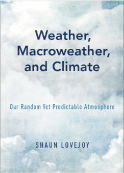Shaun Lovejoy |
Shaun Lovejoy |
New Scaling review paper, August 2023: Scaling, dynamical regimes, and stratification. How long does weather last? How big is a cloud?
New presentation (Jan. 16, 2023): The future of climate modelling
Nov. 28, 2022: As the Ukraine war derails efforts to solve the climate crisis, a new one looms — the fight for peace. Online.
 (image: Tadas Razmas)
(image: Tadas Razmas)
New paper (June 22) with Andrej Spiridinov in Nature discusses which rules evolutionary change: Life or the Climate? (press release).
Life rather than climate influences diversity at scales greater than 40 million years
January 19, 2022: New climate projections to 2100: Procyk, R., Lovejoy, S., and Hébert, R.: The fractional energy balance equation for climate projections through 2100, Earth Syst. Dynam., 13, 81–107, https://doi.org/10.5194/esd-13-81-2022. Press release.McGill Tribune piece by Sonja Soo.

The new paper based on the Fractional Energy Balance Equation (FEBE) gives a slightly smaller warming but a much smaller range of outcomes in 2100 (compare the General Circulation Model (GCM) outcomes in grey with the FEBE outcomes in blue).
New book review by Tommaso Alberti of "Weather, Macroweather and Climate" (Lovejoy 2019).
Interview on the occasion of Earth Day 2021, 22 Avril, avec Guylaine Jean radio Plaisir (en Français, 20 minutes).
Climate Dynamics highlighted paper of the year 2021, free download until March 22: A new approach allows us to reduce uncertainties in future warming. Media: Le Métro (French), The prevention Web.
The paper:
Hébert, R., · Lovejoy, S. · Tremblay, B., 2020: An observation-based scaling model for climate sensitivity estimates and global projections to 2100, Climate Dynamics, doi.org/10.1007/s00382-020-05521-x.
Youtube: Scaling, fractals and the search for high level laws in weather, macroweather and the climate, European Geosciences Union conference series on Perspectives on Climate Sciences: From historical developments to research frontiers (21.9.2020).
Video: Scaling, complexity, high level laws in weather, macroweather and the climate, Centre for Complex Systems Studies. Youtube version. (28.9.2020).
Video of the amazing StocSIPS model in simulation mode. The simulation is actually quite amazing in that it reproduces huge regional patterns including El Nino and La Nina events that are emergent properties of the model. It is important to realize that the simulation (right) is NOT supposed to be the same as the reality (left), it is only supposed to have the same type of variability (the date above the simulation is totally fictional). In other words, if no dates or labels were given could you tell which was the reality and which was the simulation?
An important point about the model is that in spite of the long range "teleconnection" patterns, these patterns do NOT help in forecasting the future state: there is no Granger causality.

Weather, Macroweather and the Climate: Our Random Yet Predictable Atmosphere. Table of contents, Preface, Shaun Lovejoy, Oxford University Press. Click here for a flyer with 30% discount, and some book information.
Video of popular lecture (in French): Quebec Skeptical Society (June 13 2020): "Comment le hasard peut améliorer les prévisions saisonnières et réduire l’incertitude des projections climatiques". La presentation powerpoint.
Interview:
“I got into the field in a way that would be virtually impossible today…”: Interview by Tommaso Alberti on Nonlinear geoscience.
Book Review:
An introduction to our chaotic atmosphere and climate: a review by Costas Varotsos of “Weather, macroweather and climate: our random yet predictable atmosphere” (Physics Today, 2020). For scanned version, click here.
Review of Weather, Macroweather and the Climate, by Adrian Tuck(Weather, February 2020).
Book video clips:
Popular talk "How Big is a Cloud?" presented at McGill's Freaky Friday venue, December 6, 2019. It explains simply how this apparently innocuous question led to a new understanding of the atmosphere: neither 2D (flat), nor 3D (voluminous), it is in between: 23/9D (2.55 D).
The Richardson medal Lecture, April 8, 2018, European Geosciences Union, Vienna: Reuniting Richardson's strands
Video of the Caltech version of the Richardson Lecture (May 8, 2019).
Video of Richardson's two strands, presented at the National Center for Atmospheric Research, Nov. 14, 2019.
Science politics
The sorry state of Climate and Atmospheric Science funding in Canada. (Montreal Gazette, Oct. 17, 2019)
Recent news
Video of: Scaling, extremes and mass extinctions in the megaclimate regime, March 28, Mathematical Biology Institute, Columbus Ohio
(Mathematical Biology Institute, Columbus Ohio, March 28, 2019).
New: nonspecialist book, released March 19, published March 28 (US), April 16 (UK), 2019:
August 23, 2018: Analyzing extreme weather and climate: a new statistical tool. McGill Press release on the new paper: Lovejoy, S., 2018: Spectra, intermittency, and extremes of weather, macroweather and climate, Nature Scientific Reports.
May 14, 2018: New approach to global-warming projections could make regional estimates more precise. McGill press release.
Global news article: "Western provinces should brace for hotter temperatures than expected by 2050"
Paperback version of "The Weather and Climate: Emergent laws and Multifractal Cascades" now available, discount price for limited period.
Assessment of Abbot and Marohasy's claim that most of the warming is natural
Climate Closure, the film (16 minutes)
January 2017:
The revolutionary STOChastic Seasonal, Interannual Prediction (StocSIPS) system for atmospheric forecasting has been awarded a Fessenden Professorhip (McGill).
A new review paper describing the science of StocSIPS can be downloaded here.
For operational monthly, seasonal and annual temperature forecasts, click here.

Shaun Lovejoy
Ph.D. (McGill '81) Professor - Mini CV
Contact Info:
Phone: (514) 398-6537
Fax: (514) 398-8434
E-mail:
[email protected]
Office Address:
McGill University
Rm 213, Rutherford Physics
Montreal, Quebec
To order: Cambridge Press. View Flyer.
More Information: Presentation | Preface | Table of Contents
Turbulent and turbulent-like systems are ubiquitous in the atmosphere but there is a gap between classical models and reality. Advances in nonlinear dynamics, especially modern multifractal cascade models, allow us to close the gap, to investigate the weather and climate at unprecedented levels of accuracy, comparing theories, models and experiments over huge ranges of space-time scales.
Using new stochastic modelling and data analysis techniques, this book provides an overview of the nonclassical, multifractal statistics. The authors demonstrate that by generalizing the classical turbulence laws, it is possible to obtain emergent laws of atmospheric dynamics. These higher level laws are empirically validated from weather to lower-frequency macroweather scales to even lower frequency climate scales, and length-scales of millimetres to the size of the planet. By generalizing the notion of scale, atmospheric complexity is reduced to a manageable scale-invariant hierarchy of processes, thus providing a new perspective for modelling and understanding the atmosphere. This new synthesis of state-of-the-art data and nonlinear dynamics is systematically compared with other analyses and global circulation model outputs. Applications of the theory are graphically demonstrated with many original multifractal simulations.
This thorough presentation of the application of nonlinear dynamics to the atmosphere is an important resource for atmospheric science researchers new to multifractal theory. It will also be of use to graduate students in atmospheric dynamics and physics, meteorology, oceanography and climatology.